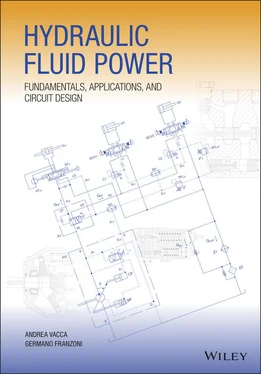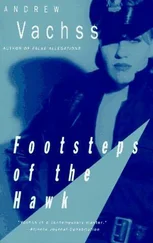9 Chapter 9Figure 9.1 Cross‐section of a spring‐loaded accumulator. The supply port P i...Figure 9.2 Piston‐type gas‐loaded accumulator.Figure 9.3 Diaphragm‐type gas‐loaded accumulator.Figure 9.4 Bladder‐type gas‐loaded accumulator.Figure 9.5 Operating conditions for a bladder accumulator: precharge conditi...Figure 9.6 Simplified circuit for hydraulic brakes.Figure 9.7 Accumulator in a vehicle suspension circuit.Figure 9.8 Use of an accumulator for pulsation dampening.Figure 9.9 Polytropic behavior of the gas inside the accumulator.Figure 9.10 Accumulator for pressure dampening.
10 Chapter 10Figure 10.1 Control variables for a linear (a) and rotary (b) actuators.Figure 10.2 A cylinder compressing material (a), or a rotary actuator drivin...Figure 10.3 Simple example for understanding resistive and overrunning loads...Figure 10.4 Resistive and assistive loads for linear actuators.Figure 10.5 Resistive and assistive loads for motors.
11 Chapter 11Figure 11.1 The basic control concepts involved in the control of a single a...Figure 11.2 Control concepts in case of flow supply. Each architecture is re...Figure 11.3 Control concepts in case of pressure supply. Each architecture i...Figure 11.4 Primary control with fixed (a) or variable displacement flow (b)...Figure 11.5 Metering controls with fixed displacement flow supply: the conce...Figure 11.6 Metering controls with variable displacement flow supply. Advanc...Figure 11.7 Secondary control with flow supply with fixed displacement pump ...Figure 11.8 Primary control with pressure supply circuits using fixed displa...Figure 11.9 Pressure supply of primary control with a variable displacement ...Figure 11.10 Pressure supply, metering controls using fixed displacement pum...Figure 11.11 Pressure supply of metering control with a variable displacemen...Figure 11.12 Pressure supply of secondary controlled circuits. The circuits ...
12 Chapter 12Figure 12.1 Basic illustration of the regeneration concept: (a) standard ext...Figure 12.2 Regeneration achieved using a standard DCV and two external valv...Figure 12.3 Example of spools with regenerative extension. Standard 4/3 DCV ...Figure 12.4 Example of open‐center type spool with regenerative extension po...Figure 12.5 Circuit with automatic selection of the regenerative extension d...Figure 12.6 Characteristics of the automated regenerative circuit of Figure ...Figure 12.7 “On demand” regeneration circuits solenoid actuated.
13 Chapter 13Figure 13.1 General layout for the meter‐in (a) and the meter‐out (b) contro...Figure 13.2 Meter‐in control concept using a fixed (a) and a variable (b) di...Figure 13.3 Control modes for the actuator in the circuits shown in Figure 1...Figure 13.4 Power consumption analysis for the circuits of Figure 13.2 : (a)...Figure 13.5 Meter‐out control concept using a fixed (a) and a variable (b) d...Figure 13.6 Control of the actuator velocity with the circuits in Figure 13....Figure 13.7 Power consumption analysis for the circuits in Figure 13.5 for r...Figure 13.8 Control of the actuator velocity with the circuits in Figure 13....Figure 13.9 Power consumption analysis of the basic meter‐out control circui...Figure 13.10 Summary of the possible meter‐in and meter‐out control situatio...Figure 13.11 Proportional DCV with meter‐in and meter‐out areas and simplifi...Figure 13.12 Different designs of independent metering elements: (a) meterin...Figure 13.13 The loader attachment for a tractor is a typical example of use...Figure 13.14 Anticavitation valve: schematic (a) and real valve characterist...Figure 13.15 Pressurization of return lines for anti‐cavitation function usi...
14 Chapter 14Figure 14.1 Spool (a) and poppet (b) elements achieving a similar functional...Figure 14.2 Pilot operated check valve (a) and equivalent symbol (b).Figure 14.3 Typical circuit utilizing a pilot operated check valve for load ...Figure 14.4 ISO symbol for a counterbalance valve.Figure 14.5 Working principle of a counterbalance valve.Figure 14.6 Typical architecture of a CBV.Figure 14.7 CBV during the check valve operation.Figure 14.8 CBV during the pressure relief operation.Figure 14.9 CBV during the pilot pressure operation.Figure 14.10 Application of CBVs for controlling the motion of a linear actu...Figure 14.11 Steady‐state operation of a counterbalance valve for different ...Figure 14.12 CBV steady state characteristic for different valve settings: (...Figure 14.13 A counterbalance valve can be approximated as a variable orific...Figure 14.14 Different solutions for CBV spring chamber drain: internal drai...Figure 14.15 Operating characteristic of the circuit in Figure 14.10 with ve...
15 Chapter 15Figure 15.1 Principle of operation of bleed‐off (a) and open center (b).Figure 15.2 Typical circuit applying a bleed‐off strategy to control the spe...Figure 15.3 Pressure and flows in the bleed‐off system, for different input ...Figure 15.4 Energy plot for the bleed‐off circuit in Figure 15.2.Figure 15.5 Typical layout of an open center system (a) with detailed view o...Figure 15.6 Pump pressure and flow (a), and area (b) trends for an open cent...Figure 15.7 Influence of load pressure (a) and pump flow (b) on the control ...Figure 15.8 Cross sections (a, b) of an open center valve and equivalent spo...Figure 15.9 Energy plot for the open center circuit in Figure 15.5.Figure 15.10 Basic architecture of a negative flow control system. The pump ...Figure 15.11 Relationship between displacement V pand pilot pressure p sin a...Figure 15.12 Pump pressure and flow (a) and area (b) trends for an open cent...Figure 15.13 Detailed view of a possible control concept for negative flow c...Figure 15.14 Actual implementation of the negative flow control for an axial...Figure 15.15 Basic architecture of a positive flow control system. The pump ...Figure 15.16 Relationship between displacement V pand pilot pressure p sin a...Figure 15.17 Detailed view of a possible control concept for positive flow c...Figure 15.18 Energy plot for the advanced open center systems.
16 Chapter 16Figure 16.1 Load sensing principle (flow supply, fixed displacement pump) fo...Figure 16.2 Limiting the maximum pressure in the LS system of Figure 16.1: w...Figure 16.3 Energy plot of the LS system in Figure 16.1.Figure 16.4 Flow rate provided to the actuator by the LS system in Figure 16...Figure 16.5 LS system with fixed displacement pump using a 5/3 proportional ...Figure 16.6 5/3 Proportional LS valve architecture, with integrated work‐por...Figure 16.7 LS system with a variable displacement pump: (a) conceptual sche...Figure 16.8 Energy plot of the LS system in Figure 16.7Figure 16.9 Detailed ISO schematic of a variable displacement pump with pres...Figure 16.10 Variable displacement pump with pressure limiter and differenti...Figure 16.11 Detail of the differential pressure limiter during regulation....Figure 16.12 Load sensing system using independent metering elements.Figure 16.13 Circuit implementing the electronic LS principle.
17 Chapter 17Figure 17.1 Constant pressure system using a variable displacement pump.Figure 17.2 Pump pressure (a), flow, and area trends (b) for a constant pres...Figure 17.3 Influence of the load on the actuator flow in a constant pressur...Figure 17.4 Energy plot for the constant pressure circuit of Figure 17.1.Figure 17.5 Constant pressure system with unloader and variable setting pres...Figure 17.6 Typical layout of a constant pressure system supplied by a fixed...Figure 17.7 Pressure trends in the circuit, starting from an empty accumulat...Figure 17.8 Constant pressure circuit for braking applications.
18 Chapter 18Figure 18.1 Basic concepts for series (a, c) and for parallel (b, d) connect...Figure 18.2 Circuit with two actuators in series.Figure 18.3 Analysis of the motion of two actuators in parallel.Figure 18.4 Circuit with two actuators in parallel and directional control v...Figure 18.5 Use of a compensator for synchronizing the motion of two actuato...Figure 18.6 Volumetric coupling to achieve synchronism between actuators in ...Figure 18.7 Spool type flow divider: (a) simplified ISO symbol, detailed sch...Figure 18.8 Cross‐sectional view of a spool‐type flow divider.Figure 18.9 Application of a flow divider combiner (FDC) to control the exte...Figure 18.10 Spool type flow divider/combiner: detailed and simplified ISO s...Figure 18.11 Flow divider/combiner: operation as a flow divider.Figure 18.12 Flow divider/combiner: operation as a flow combiner.Figure 18.13 Cross‐sectional view of a spool type flow divider‐combinerFigure 18.14 Volumetric flow divider/combiner using intermediate dual rod cy...Figure 18.15 Two‐way rotary flow divider/combiner.Figure 18.16 Example of four‐way rotary flow divider/combiner. Each line is ...
Читать дальше












